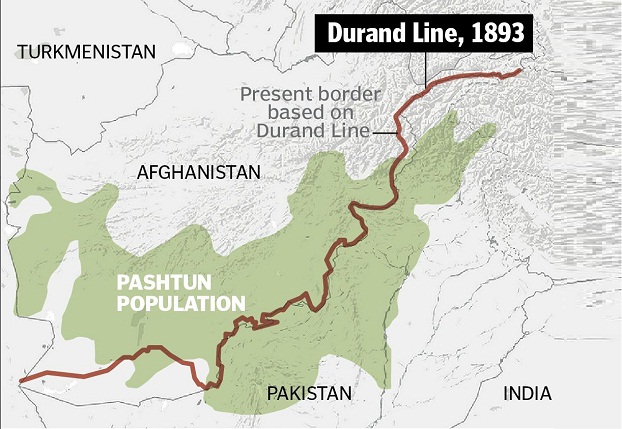The 2,430-kilometer long Durand Line was signed in 1893 as a non-popular agreement between Sir Mortimer Durand, a diplomat and civil servant of British India and Afghan king, Abdur Rahman Khan. The line cuts along the Pashtun tribal areas and further south through the Baluchistan region, dividing Pashtun and Baluch ethnics, living on sides. The Durand Line was drawn for administrative purpose, not as a permanent border.
From a geopolitical and geostrategic perspective, it has been described as one of the most dangerous and disputed imperialistic lines. Actually it was a defensive strategy of British India against Russian expanding policy. Pakistan that was born many years later, has been attempting to force Afghanistan to formally recognize it as a permanent border line. Afghanistan considers that the Durand Line agreement is not applicable to Pakistan. On July 26, 1949, when Afghan-Pakistan relations were rapidly deteriorating, a Loya Jirga declared that it recognized neither the imaginary Durand and nor any similar line and that all previous Durand Line agreements were unacceptable.
The Joya Jirga also announced that the line had been imposed on Afghans and was a diktat. Since its birth, Pakistan remained disputed for Afghanistan and to the Pashtun and Baluch tribes across the Durand Line. That’s why unilaterally Durand Line could not be recognized as a permanent border. The seven tribal agencies and five frontier regions, Khyber Pakhtunkhwa including Mianwali and Dera Ghazi Khan, Pashtun areas of Baluchistan including Sibi that borders Sindh province of Pakistan historically belong to Afghanistan.
The Gandamak treaty signed on 26 May, 1879 by King Mohammad Yaqub Khan and Sir Louis Cavagnari of British government of India also recognize it as the territory of Afghanistan. According to the international norms, the governments of Islamabad and Kabul have no moral and legal authorities to decide over the Line. Durand line issue can only be decided by the people of Afghanistan. Unfortunately, some individuals who pay less attention to the national interests express readiness for the line recognition.
Abdul Latif Pedram, a politician has said that Durand Line should be recognized as a permanent border to ensure durable peace and stability in the country.
Pedram’s statement was condemned by the people on both sides of the Line, including parliamentarians.
Afghanistan peace and stability does not depend on the non-recognition of Durand Line as permanent border. Insecurity and instability have been imposed the enemies, following strategic goals in our country. Islamabad still continues the British forward policy and strategic depth into Afghanistan. Peace and stability in our country is needed for national unity and firm commitment against our enemies. The government has to frame some laws against national and territorial corruption because it is more dangerous than the financial and individual corruption. Pedram regarding his statement should be questioned inside the parliament and as well in the court of public because this is a vital matter for the Afghan territory and nation. Statements in favor of recognition to the Durand Line as a permanent border with Pakistan would be an insult to our martyrs. Territorial history and integrity cannot be compromised at any cost.
 Afghanistan Times
Afghanistan Times


